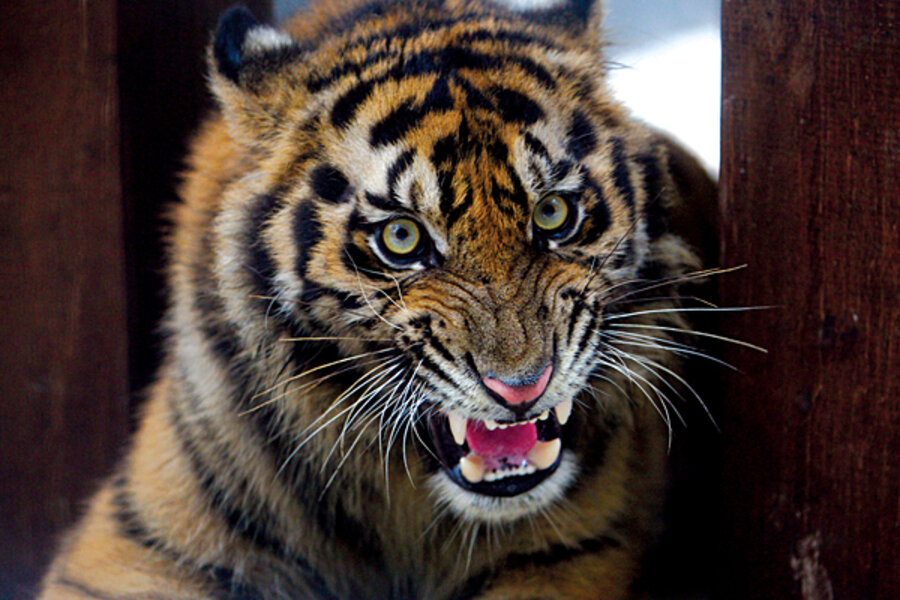Why exotic animal trade grows in Asia
Loading...
| Jakarta, Indonesia
On a traffic-snarled Jakarta roadside, a market trader thrusts out a forearm with a terrified looking primate clasping tightly to his skin.
"You can have it for 300,000 rupiah [$30]," he says of the slow loris, a protected species whose sluggish movement makes it easy prey for poachers. The destruction of its habitat and its low reproduction rate are why the loris is classified as facing extinction under the Convention on International Trade in Endangered Species, which bans their trade.
But here at the Jatinegara market, there is no attempt to conceal the sale of loris or many other endangered species. Orangutans, Sumatran tigers, and Javan eagles are just a few of the threatened species in Indonesia's animal markets.
It is a scenario that has been playing out across Southeast Asia for centuries, but with increased speed in the past decade, as a burgeoning class of wealthy Asians who cherish rare creatures as exotic pets, delicacies, or for supposed medicinal qualities fuel a booming and illegal trade.
The plunder – a small piece of the greater challenge of environmental conservation in Indonesia – is happening in conjunction with habitat depletion, and conservationists fear some species will soon disappear while new ones tumble onto the endangered list.
"Rare animals have become status symbols. They are trophies for people to demonstrate their wealth and the collateral damage of Asia's economic rise," says James Compton, senior director for Asia-Pacific at Traffic, a conservation group that monitors wildlife trade.
"We will see some local populations of endemic species disappear very quickly. Look at what happened to the tiger population over the past 100 years," he says.
The Association of Southeast Asian Nations Wildlife Enforcement Network predicts that between 13 and 42 percent of the region's animal and plant species will be wiped out this century, mostly due to logging and loss of habitat.
The United Nations Food and Agriculture Organization estimates that Indonesia loses 6.2 million acres of forest – equivalent to the size of Vermont – every year. By 2008, Indonesia had lost 72 percent of its ancient forests, and what remains is threatened by commercial logging, forest fires, and clearing for palm oil plantations, according to Greenpeace.
The multibillion-dollar exotic animal trade pits underfunded enforcement agencies against poor, rural communities. It has a criminal supply chain that stretches from forests in Indonesia, Thailand, Vietnam, and the Philippines to the dinner tables of Asia's elite in China, Japan, and South Korea. Fanned by widespread corruption, the trade flouts international and local laws protecting endangered species, making crackdowns difficult.
Markets such as Jatinegara draw swarms of local and foreign buyers despite the efforts of global agencies, including the International Criminal Police Organization, to bust them.
"As soon as these traders see the police, they pack up and leave.... So we are working on doing more undercover operations to shut these places down," says Raffles Panjaitan, Indonesia's director of investigation and forest protection.
Recent crackdowns have discovered tiger parts, rhino horns, and a bear head destined for the Chinese medicine trade.
But Mr. Panjaitan says he needs more resources: He has just 8,400 police covering Indonesia's 510,000 square miles of forest. "Many Indonesians living in or near forests have little income, and poachers persuade them with a little bit of money to hunt protected species," he says. "They usually aren't educated in these areas, and they don't know these animals are endangered or understand conservation."
Conservationists agree that a combination of tighter enforcement and education is critical to finding a lasting solution.
Persuading buyers, and the forest communities who poach for sums far below the amount a creature sells for, of the need to preserve biodiversity is as crucial as punishing them, say environmentalists.
One recent example of such a campaign is Vietnam, where a myth about the cancer-curing effects of rhino horn created a surge in the number of rare rhinos being killed in the region and in their African habitat. In an effort to shift the mind-set there, conservationists worked with the nation's Communist Party to educate the population, tapping into and directly informing wealthy officials and the business contacts who are the main consumers of exotic pets, delicacies, and medicines.
But campaigns often move at a glacial pace, and there are frequent reminders of the size of the conservationists' task.
This month an endangered Sumatran tiger died after it was rescued from a wire trap in an Indonesian jungle with injuries caused by spears and air rifle pellets. There are fewer than 400 of the tigers left.
Says Mr. Compton, "We have to be realistic. The economic imperative for some communities in this region is stronger than the will to protect the environment."
Get daily or weekly updates from CSMonitor.com delivered to your inbox. Sign up today.





